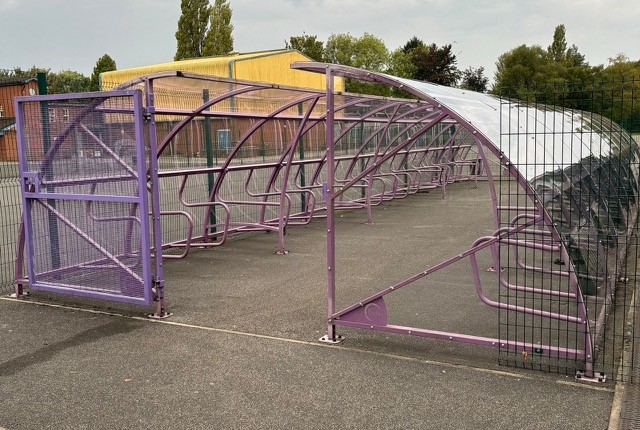
Introduction
Summer in the UK is a season many look forward to—longer days, warmer weather, and a general sense of optimism that leads more people to embrace outdoor activities. Among these is cycling. As bike usage increases during the summer months, so too does an unfortunate side effect: a sharp rise in bicycle theft. Whether for commuting, leisure, or eco-friendly travel, cyclists are more active during the summer, which creates new opportunities for thieves.
For businesses, schools, councils, and property managers that provide cycle shelters, this seasonal spike raises an urgent question: Are your bike storage facilities secure enough to protect what matters? In this blog, we’ll explore why theft increases in summer, the common security failings of traditional cycle shelters, and how you can significantly improve your bike storage infrastructure to prevent losses.
Why Bike Theft Peaks During the Summer Months
Statistics from local councils, law enforcement, and cycling organisations indicate a noticeable surge in bike theft between May and September. In fact, some reports suggest a rise of over 130% in bike-related crime during this period.
The reason is simple: more people are using their bikes and leaving them unattended in public spaces. Longer daylight hours mean extended periods of exposure, especially outside workplaces, schools, transport hubs, and public venues. Opportunistic thieves take advantage of this increased availability, often targeting areas with poorly secured bike shelters or minimal surveillance.
Even homes are not exempt. As families take holidays or leave bikes in gardens and sheds during sunny spells, thefts from residential properties also spike. While indoor storage is ideal, it’s not always practical—especially in commercial or multi-occupancy environments where external bike shelters are essential.
The Most Common Weaknesses in Cycle Shelter Security
While the presence of a bike shelter offers a degree of protection, not all shelters are created equal. Many existing shelters, especially those installed years ago or designed for aesthetics rather than functionality, have several vulnerabilities.
1. Inadequate structural strength
Some shelters use lightweight materials or poorly anchored frames, making them easy targets for forced entry or dismantling. Shelters made with thin aluminium or substandard polycarbonate panels can be breached in minutes.
2. Poor visibility
Shelters tucked away in dark corners, surrounded by tall hedges or placed away from pedestrian traffic, offer cover for thieves. Low visibility areas give criminals time and confidence to remove locks or damage bikes undisturbed.
3. Lack of lighting or deterrence
A surprising number of shelters lack basic lighting. Without motion-activated or timed lighting, the shelter becomes a high-risk zone after sunset. Absence of signage about surveillance, community watch, or property ownership also reduces the psychological barrier for criminals.
4. Ineffective locking mechanisms
Some shelters don’t provide adequate racks or locking points. Cyclists are forced to lock only one part of the bike—usually the front wheel—which can be quickly detached and stolen. A secure shelter must accommodate locking both wheels and the frame securely to a fixed point.
5. Insufficient access control
In many corporate or residential settings, shelters are accessible to the public. Without keypad, fob, or passcode entry systems, any individual can access the shelter, increasing the risk of theft even in monitored premises.
How to Improve the Security of Your Cycle Shelter
Upgrading your cycle shelter doesn’t always mean starting from scratch. Often, a combination of infrastructure, placement, policy, and awareness can significantly improve safety.
1. Invest in robust, weatherproof shelters
Look for shelters constructed with steel frames, secure fixing systems, and high grade impact resistant polycarbonate or security-grade glass. Modular shelters can be fitted with access doors or security gates, further enhancing their theft resistance.
High-quality shelters are not only more secure, but they also deter would-be thieves who prefer low-risk, quick-access targets.
2. Install the shelter in a visible, high-traffic area
Visibility is one of the most powerful deterrents. Position shelters in well-lit, open spaces visible from office windows, reception areas, or busy pedestrian zones. Shelters in overlooked or high-footfall areas reduce the likelihood of undetected criminal activity.
3. Add lighting and signage
Lighting should not be optional. Install motion-sensor lights that activate when movement is detected within or around the shelter. Additionally, signage stating “CCTV in Operation,” even if just a deterrent, can reduce the chances of theft significantly.
4. Encourage proper locking methods
Users must be educated on how to use the shelter effectively. Provide signs or leaflets explaining the best ways to lock a bike—ideally using two locks, securing both wheels and the frame. Visual guides can encourage better habits among employees, students, or residents.
5. Introduce controlled access
Where possible, consider adding an access control system to the shelter. This could be a mechanical code lock, key fob system, or digital keypad. Restricting access to authorised users creates accountability and limits the risk of strangers entering the premises to steal bikes.
6. Encourage registration and insurance
As part of your bike policy, advise users to register their bicycles with official platforms like BikeRegister. Some shelters even provide QR-code-enabled panels linking to registration platforms. Cyclists should also insure their bikes—especially higher-value models commonly used by commuters.
Consequences of Insecure Cycle Storage
The financial impact of a stolen bike can be considerable, especially as more people invest in expensive models. However, the long-term consequences often extend beyond the price tag.
1. Drop in cycling participation
Many cyclists report giving up on riding altogether after a theft. For workplaces, this translates to reduced uptake of cycle-to-work schemes, less sustainable commuting, and lower staff morale. In schools and universities, stolen bikes discourage students from adopting cycling as a mode of transport.
2. Insurance claims and reputational risks
When bike theft occurs regularly on your premises, especially in business parks or residential developments, it can tarnish your reputation. For facility managers and developers, unresolved theft issues can result in complaints, negative reviews, or even legal claims from tenants.
3. Health and sustainability setbacks
Government strategies in the UK actively promote cycling for health, environmental, and congestion-reduction benefits. But repeated theft undermines this initiative. Without secure storage, active transport goals become harder to achieve, affecting corporate responsibility targets and local council sustainability benchmarks.
How Organisations Can Lead the Way in Bike Security
Businesses, councils, and institutions have a duty of care to provide safe infrastructure for cyclists. Fortunately, many are already making strides to improve security.
Corporate parks now require Secured by Design-compliant shelters as part of their property planning.
Schools and Universities are investing in monitored bike pods and two-tier shelters with integrated CCTV.
Councils are allocating budgets for public cycle hubs with enhanced access control and remote monitoring.
Tamstar has worked with clients across all these sectors to provide durable, visually appealing, and security-conscious shelter solutions. Whether adapting a smoking shelter to accommodate cycle storage or installing custom-built units, our products offer a combination of resilience and flexibility.
Choosing the Right Shelter: What to Look For
When selecting or upgrading a cycle shelter, it’s worth assessing both short- and long-term needs. Here’s a checklist of features to consider:
- Galvanised or powder-coated steel frame
- UV-resistant polycarbonate panels
- Tamper-resistant fixings and anchors
- Ground-embedded or bolt-down base
- Integrated bike racks compatible with U-locks
- Space-efficient design with high capacity (including two-tier option racks)
- Custom branding or signage panels
- Optional lighting and CCTV
- Access control compatibility
By integrating these features, facility managers can offer a secure and user-friendly cycling experience to staff, students, or the public.
Final Thoughts
With summer’s arrival comes an inevitable rise in cycling—and unfortunately, in bike theft. The good news is that with the right approach to shelter design and security, you can significantly reduce your risk. Whether you’re a facilities manager at a school, HR director at a company, or estate developer planning your next project, investing in secure cycle shelters is no longer optional—it’s essential.
Tamstar is here to support you with quality shelters designed to withstand weather, wear, and worst-case scenarios. As cycling continues to grow in popularity, let’s ensure that the infrastructure protecting our bikes keeps pace.
Is your cycle shelter secure enough? If you’re unsure, it’s time to find out.
